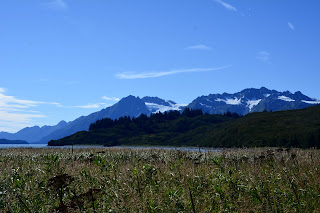When we left this morning at 7 a.m. (which means getting up at 5 a.m.) it was in the upper 30s. Winter is coming on in the Yukon. But, it was another fine day for viewing stupendous scenery, so let's get going!
The RV park in Destruction Bay was right across from Kluane Lake, the largest lake in the Yukon.
I love the fall colors below and the fresh snow on the mountain tops. You can see the snow line.
We were just passing Tachal Dhal, formerly known as Sheep Mountain, when we we saw some.
They were all the way up the side of the mountain, and...
clustered on the road.
The snow line is very visible in this picture.
More fall color.
This is an intriguing drainage pattern on the side of this mountain.
At Haines Junction in Yukon, we turned south on the Haines Highway, 146 miles to Haines, Alaska. Noted for its grand views of glaciated mountains and the variety of its scenery - from wooded hillsides to alpine tundra, then back to coastal forests.
No trees in the alpine tundra.
Glaciated mountains.
One of these is Jarvis Glacier and another is Saksaia Glacier.
Passing right through Canadian Customs on the right side of the road.
U.S.Customs, Dalton Cache crossing.
And just like that, we were back in Alaska!
The road winds through the Chilkat River flats outside Haines.
We're glad to be here!


























































